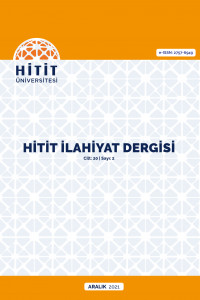Reshaping Alien Silhouette and Transforming Islamic Skyline of the Previously Ottoman Settlements; the Case of Greece
Öz
Anahtar Kelimeler
Geography Historical Geography Ethnocultural-Environment Spatial Transformation Architectural Environment Islamic Skyline Greece
Kaynakça
- Adi, Hima. “The Cham Issue: Past, Present and Solutions in the Light of European Integration of South East Europe”. SSRN Electronic Journal (2010), 1-118.
- Aktis. “Alak Imaret Mosque/Ishak Pasha Mosque, Thessaloniki, Thessaloniki Region, Central Macedonia, Greece”, 2021. Date of Access: 10 May 2021. https://aktis.app/ru/Attraction-Alatza_Imaret-p370-r189473-Thessaloniki.
- Anadolu Agency. “Greek Mayor Fights to Preserve Ottoman Heritage”, 2017. Date of Access: 17 May 2021. https://www.aa.com.tr/en/culture-and-art/greek-mayor-fights-to-preserve-ottoman-heritage/964158.
- Çelikkol, Zeki. Rodos'taki Türk Eserleri ve Tarihçe 6. Ankara: Türk Tarih Kurumu Yayınları, 1992.
- Dramini. “The Restoration of the Arab Mosque in Drama was Raised with Other İssues in the Ministry of Culture”, 2017. Date of Access: 10 May 2021. https://www.dramini.gr/i-apokatastasi-tou-temenous-arap-tzami-sti-drama-tethike-me-alla-themata-sto-ypourgio-politismou/.
- Eren, Halit. “Batı Trakya Türkleri”, İstanbul: Rebel Basım, (1997). 93.
- Forum Anavatan Rumeli. “Main Page”, 2021. Date of Access: 4 May 2021. www.anavatanrumeli.org.
- Greek Official Gazette. “FEK A’ 128, Article 27”, 21 June 2006.
- Hüseyinoğlu, Ali. “Islam and Religious Liberties in Western Thrace, Greece”. Islam in the Balkans Unexpired Hope 4/19 (2016), 141-158.
- iStock. “Thessaloniki, Greece - August 16, 2018: View of Thessaloniki from the Sea”. 2018. Date of Access: 15 June 2021. https://www.istockphoto.com/br/foto/vista-de-sal%C3%B3nica-do-mar-gm1032521160-276550309.
- Milliyet, “Batı Trakya’da resmi gasp”, 2009. Date of access 28 May 2021. https://www.milliyet.com.tr/dunya/bati-trakya-da-resmi-gasp-1128500
- Papadopoulos, Stergios. “Old Thessaloniki”, 2021. Date of Access: 10 June 2021. https://www.pinterest.com/pin/741545894870148161/.
- Republic of Turkey Ministry of Foreign Affairs. “Turkish Minority of Western Thrace and the Turkish Community in the Dodecanese”, 2021. Date of Access: 2 May 2021. https://www.mfa.gov.tr/turkish-minority-of-western-thrace.en.mfa.
- Sözcü, “Dimetoka’daki Tarihi Caminin Minaresine Yunan Bayrağı Astılar”, 2020. Date of Access: 20 May 2021. https://www.sozcu.com.tr/2020/dunya/dimetokadaki-tarihi-caminin-minaresine-yunan-bayragi-astilar-5847457/#:~:text=Yunanistan'%C4%B1n%20Edirne%20s%C4%B1n%C4%B1r%C4%B1nda%20bulunan,edilmesinin%20ard%C4%B1ndan%20belediye%20taraf%C4%B1ndan%20indirildi.
- Takvim, “Rodos Savaşı”, 2012. Date of access 23 May 2021. https://www.takvim.com.tr/ guncel/2012/ 09/10/rodos-savasi
- Thanasis Giochalas –Tonia, Kafetzaki. Αθήνα: Ιχνηλατώντας την πόλη με οδηγό την ιστορία και τη λογοτεχνία [Athens: Tracing the city through history and literature]” (in Greek). Athens: Estia, 2013, 109.
- Trakya’nın Sesi. “Dimetoka Beyazıt Camii Restorasyonunun 2023’te Tamamlanması Öngörülüyor”, 2019. Date of Access: 13 June 2021. http://www.trakyaninsesi.com/haber/25884/dimetoka-beyazit-camii-restorasyonunun-2023te-tamamlanmasi-ongoruluyor.html.
- Travel Orama. “City Tours”, 2021. Date of Access: 10 May 2021. https://www.toursgreece.gr/city-tours/
- Velogiannis Manthos. "H διαχείριση των μουσουλμανικών και εβραϊκών ιερών μνημείων στη Θεσσαλονίκη" [The management of Muslim and Jewish shrines in Thessaloniki] (in Greek). Patras, 2018
- Yılmaz, Mehmet Emin. Kiliseye Çevrilen Türk Eserleri. İstanbul: İstanbul Fetih Cemiyeti, 2020.
- Yunan Cumhuriyeti Eğitim, Araştırma ve Din İşleri Bakanlığı Din İşleri Genel Sekreterliği Din İdaresi Daire Başkanlığı. “Farklı Dinler ve Mezhepler Şubesi Genelgesi, Sayı: 57071/TH1”, 2017.
Yabancı Silüeti Yeniden Şekillendirmek ve Eski Osmanlı Yerleşmelerinin İslami Silüetinin Dönüştürülmesi; Yunanistan Örneği
Öz
Anahtar Kelimeler
Coğrafya Tarihi Coğrafya Etnokültürel Ortam Mekânsal Dönüşüm Mimari Ortam İslami Silüet Yunanistan
Teşekkür
Teşekkürlerimi sunuyor, akademik yayın hayatınızda başarılar diliyorum
Kaynakça
- Adi, Hima. “The Cham Issue: Past, Present and Solutions in the Light of European Integration of South East Europe”. SSRN Electronic Journal (2010), 1-118.
- Aktis. “Alak Imaret Mosque/Ishak Pasha Mosque, Thessaloniki, Thessaloniki Region, Central Macedonia, Greece”, 2021. Date of Access: 10 May 2021. https://aktis.app/ru/Attraction-Alatza_Imaret-p370-r189473-Thessaloniki.
- Anadolu Agency. “Greek Mayor Fights to Preserve Ottoman Heritage”, 2017. Date of Access: 17 May 2021. https://www.aa.com.tr/en/culture-and-art/greek-mayor-fights-to-preserve-ottoman-heritage/964158.
- Çelikkol, Zeki. Rodos'taki Türk Eserleri ve Tarihçe 6. Ankara: Türk Tarih Kurumu Yayınları, 1992.
- Dramini. “The Restoration of the Arab Mosque in Drama was Raised with Other İssues in the Ministry of Culture”, 2017. Date of Access: 10 May 2021. https://www.dramini.gr/i-apokatastasi-tou-temenous-arap-tzami-sti-drama-tethike-me-alla-themata-sto-ypourgio-politismou/.
- Eren, Halit. “Batı Trakya Türkleri”, İstanbul: Rebel Basım, (1997). 93.
- Forum Anavatan Rumeli. “Main Page”, 2021. Date of Access: 4 May 2021. www.anavatanrumeli.org.
- Greek Official Gazette. “FEK A’ 128, Article 27”, 21 June 2006.
- Hüseyinoğlu, Ali. “Islam and Religious Liberties in Western Thrace, Greece”. Islam in the Balkans Unexpired Hope 4/19 (2016), 141-158.
- iStock. “Thessaloniki, Greece - August 16, 2018: View of Thessaloniki from the Sea”. 2018. Date of Access: 15 June 2021. https://www.istockphoto.com/br/foto/vista-de-sal%C3%B3nica-do-mar-gm1032521160-276550309.
- Milliyet, “Batı Trakya’da resmi gasp”, 2009. Date of access 28 May 2021. https://www.milliyet.com.tr/dunya/bati-trakya-da-resmi-gasp-1128500
- Papadopoulos, Stergios. “Old Thessaloniki”, 2021. Date of Access: 10 June 2021. https://www.pinterest.com/pin/741545894870148161/.
- Republic of Turkey Ministry of Foreign Affairs. “Turkish Minority of Western Thrace and the Turkish Community in the Dodecanese”, 2021. Date of Access: 2 May 2021. https://www.mfa.gov.tr/turkish-minority-of-western-thrace.en.mfa.
- Sözcü, “Dimetoka’daki Tarihi Caminin Minaresine Yunan Bayrağı Astılar”, 2020. Date of Access: 20 May 2021. https://www.sozcu.com.tr/2020/dunya/dimetokadaki-tarihi-caminin-minaresine-yunan-bayragi-astilar-5847457/#:~:text=Yunanistan'%C4%B1n%20Edirne%20s%C4%B1n%C4%B1r%C4%B1nda%20bulunan,edilmesinin%20ard%C4%B1ndan%20belediye%20taraf%C4%B1ndan%20indirildi.
- Takvim, “Rodos Savaşı”, 2012. Date of access 23 May 2021. https://www.takvim.com.tr/ guncel/2012/ 09/10/rodos-savasi
- Thanasis Giochalas –Tonia, Kafetzaki. Αθήνα: Ιχνηλατώντας την πόλη με οδηγό την ιστορία και τη λογοτεχνία [Athens: Tracing the city through history and literature]” (in Greek). Athens: Estia, 2013, 109.
- Trakya’nın Sesi. “Dimetoka Beyazıt Camii Restorasyonunun 2023’te Tamamlanması Öngörülüyor”, 2019. Date of Access: 13 June 2021. http://www.trakyaninsesi.com/haber/25884/dimetoka-beyazit-camii-restorasyonunun-2023te-tamamlanmasi-ongoruluyor.html.
- Travel Orama. “City Tours”, 2021. Date of Access: 10 May 2021. https://www.toursgreece.gr/city-tours/
- Velogiannis Manthos. "H διαχείριση των μουσουλμανικών και εβραϊκών ιερών μνημείων στη Θεσσαλονίκη" [The management of Muslim and Jewish shrines in Thessaloniki] (in Greek). Patras, 2018
- Yılmaz, Mehmet Emin. Kiliseye Çevrilen Türk Eserleri. İstanbul: İstanbul Fetih Cemiyeti, 2020.
- Yunan Cumhuriyeti Eğitim, Araştırma ve Din İşleri Bakanlığı Din İşleri Genel Sekreterliği Din İdaresi Daire Başkanlığı. “Farklı Dinler ve Mezhepler Şubesi Genelgesi, Sayı: 57071/TH1”, 2017.
Ayrıntılar
| Birincil Dil | İngilizce |
|---|---|
| Konular | Din, Toplum ve Kültür Araştırmaları |
| Bölüm | Makaleler |
| Yazarlar | |
| Erken Görünüm Tarihi | 30 Aralık 2021 |
| Yayımlanma Tarihi | 30 Aralık 2021 |
| Gönderilme Tarihi | 15 Ağustos 2021 |
| Yayımlandığı Sayı | Yıl 2021 Cilt: 20 Sayı: 2 |
Cited By
Tarihi Çevrede Korumanın Üçüncü Boyutu Olarak Silüet: Korunma Sorunlarının Medya Perspektifinden İncelenmesi
GRID - Architecture Planning and Design Journal
https://doi.org/10.37246/grid.1077009
Hitit İlahiyat Dergisi Creative Commons Atıf 4.0 International License (CC BY NC) ile lisanslanmıştır.


